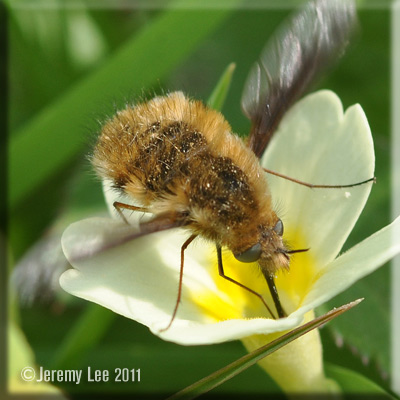
 |
|
Scientific Classifications explained » Amphibians » Ants » Aphids » Bees » Beetles » Birds » Bugs » Butterflies » Caterpillars » Damselflies » Dragonflies » Earwigs » Flies » Frog/Leafhoppers » Fungi » Galls » Grasshoppers » Harvestmen » Hoverflies » Lacewings » Ladybirds » Leaf Mines » Lichens » Mammals » Millipedes » Mosses » Moths » Sawflies » Slugs » Snails » Spiders » Trees & Shrubs » Wasps » Wild Flowers » Woodlice » Postboxes |
UK Nature > Flies > Bombylius major

Scientific Name: Bombylius major Common Name: Bee Fly Bombylius major, as its common name "Bee Fly" suggests, at least superficially, resembles a bumblebee. Its size (12-17mm in length) and all over furry body help to provide this illusion. There are ten different species of Bee Fly in Britain, Bombylius major being the most common and widespread. They can usually be seen on the wing between March and June. It is easily identified by its long, rigid proboscis, the hovering over plants and the darting, high-pitch whining flight. They do not bite or sting and prefer sunny patches on the edges of woodland, roadsides, fields and gardens. With some exceptions, Bee Flies are parasites of solitary bees and wasps. The female lays her eggs near the nests of host insects or on flowers that are visited by the host insects for their nectar and pollen. The developing larvae make their own way into the host nest or attach themselves to bees or wasps who visit the flowers to be carried into the nest by the host species. |
|

https://www.uknature.co.uk is a website dedicated to showing the immense diversity of UK nature and wildlife. Our vast range of habitats, from lowland arable to snow covered mountains, from storm-ravaged coastlines to peaceful inland freshwater lakes and rivers, from dry, sandy heaths to deciduous and coniferous forests, all these habitats contribute to the abundance of UK nature. We have wild birds in huge numbers either residing or visiting our shores (597 recorded species as at July 2013) and we must also not forget the humble back garden with its grass lawns, flower beds filled with nectar rich flowers, shrubs and trees, all designed to attract huge numbers of insects such as bees, moths, butterflies and hoverflies; and finally the small ponds which provide safe havens for frogs, toads, newts and even slow worms and grass snakes. www.uknature.co.uk is the showcase for my personal passion, photographing uknature in all its glory. I sincerely hope you all enjoy the fruits of my labours. This site and all images contained therein is © Jeremy Lee 2004 - 2025. All Rights Reserved. Site design by Jeremy Lee. Site development & IT Support by Stuart Lee. |